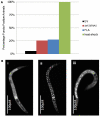The MDT-15 subunit of mediator interacts with dietary restriction to modulate longevity and fluoranthene toxicity in Caenorhabditis elegans
- PMID: 22132200
- PMCID: PMC3221695
- DOI: 10.1371/journal.pone.0028036
The MDT-15 subunit of mediator interacts with dietary restriction to modulate longevity and fluoranthene toxicity in Caenorhabditis elegans
Abstract
Dietary restriction (DR), the limitation of calorie intake while maintaining proper nutrition, has been found to extend life span and delay the onset of age-associated disease in a wide range of species. Previous studies have suggested that DR can reduce the lethality of environmental toxins. To further examine the role of DR in toxin response, we measured life spans of the nematode Caenorhabditis elegans treated with the mutagenic polyaromatic hydrocarbon, fluoranthene (FLA). FLA is a direct byproduct of combustion, and is one of U.S. Environmental Protection Agency's sixteen priority environmental toxins. Treatment with 5 µg/ml FLA shortened the life spans of ad libitum fed nematodes, and DR resulted in increased sensitivity to FLA. To determine the role of detoxifying enzymes in the toxicity of FLA, we tested nematodes with mutations in the gene encoding the MDT-15 subunit of mediator, a transcriptional coactivator that regulates genes involved in fatty acid metabolism and detoxification. Mutation of mdt-15 increased the life span of FLA treated animals compared to wild-type animals with no difference observed between DR and ad libitum fed mdt-15 animals. We also examined mutants with altered insulin-IGF-1-like signaling (IIS), which is known to modulate life span and stress resistance in C. elegans independently of DR. Mutation of the genes coding for the insulin-like receptor DAF-2 or the FOXO-family transcription factor DAF16 did not alter the animals' susceptibility to FLA compared to wild type. Taken together, our results suggest that certain compounds have increased toxicity when combined with a DR regimen through increased metabolic activation. This increased metabolic activation appears to be mediated through the MDT-15 transcription factor and is independent of the IIS pathway.
Conflict of interest statement
Figures






Similar articles
-
Calycosin promotes lifespan in Caenorhabditis elegans through insulin signaling pathway via daf-16, age-1 and daf-2.J Biosci Bioeng. 2017 Jul;124(1):1-7. doi: 10.1016/j.jbiosc.2017.02.021. Epub 2017 Apr 20. J Biosci Bioeng. 2017. PMID: 28434978
-
Lifespan-extending effects of royal jelly and its related substances on the nematode Caenorhabditis elegans.PLoS One. 2011;6(8):e23527. doi: 10.1371/journal.pone.0023527. Epub 2011 Aug 9. PLoS One. 2011. PMID: 21858156 Free PMC article.
-
SHC-1/p52Shc targets the insulin/IGF-1 and JNK signaling pathways to modulate life span and stress response in C. elegans.Genes Dev. 2008 Oct 1;22(19):2721-35. doi: 10.1101/gad.478408. Genes Dev. 2008. PMID: 18832074 Free PMC article.
-
The longevity effect of dietary restriction in Caenorhabditis elegans.Exp Gerontol. 2006 Oct;41(10):1026-31. doi: 10.1016/j.exger.2006.05.007. Epub 2006 Jun 19. Exp Gerontol. 2006. PMID: 16782293 Review.
-
Ketone bodies mimic the life span extending properties of caloric restriction.IUBMB Life. 2017 May;69(5):305-314. doi: 10.1002/iub.1627. Epub 2017 Apr 3. IUBMB Life. 2017. PMID: 28371201 Review.
Cited by
-
Caffeine extends life span, improves healthspan, and delays age-associated pathology in Caenorhabditis elegans.Longev Healthspan. 2012 Dec 1;1:9. doi: 10.1186/2046-2395-1-9. eCollection 2012. Longev Healthspan. 2012. PMID: 24764514 Free PMC article.
-
MDT-15/MED15 permits longevity at low temperature via enhancing lipidostasis and proteostasis.PLoS Biol. 2019 Aug 13;17(8):e3000415. doi: 10.1371/journal.pbio.3000415. eCollection 2019 Aug. PLoS Biol. 2019. PMID: 31408455 Free PMC article.
-
Adaptive and specialised transcriptional responses to xenobiotic stress in Caenorhabditis elegans are regulated by nuclear hormone receptors.PLoS One. 2013 Jul 26;8(7):e69956. doi: 10.1371/journal.pone.0069956. Print 2013. PLoS One. 2013. PMID: 23922869 Free PMC article.
References
-
- McCay CM, Crowell MF, Maynard LA. The effect of retarded growth upon the length of life and upon ultimate size. J Nutr. 1935;10:63–79. - PubMed
-
- Masoro EJ. Overview of caloric restriction and ageing. Mech Ageing Dev. 2005;126:913–922. - PubMed
-
- Weindruch R, Walford RL. The retardation of aging and disease by dietary restriction. Springfield, IL: Charles C. Thomas; 1988.
Publication types
MeSH terms
Substances
Grants and funding
LinkOut - more resources
Full Text Sources
Molecular Biology Databases
Research Materials
Miscellaneous

